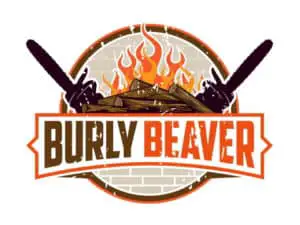Chainsaws are made to take a beating, but there comes a time when some parts need replaced. So, how do you tell when your chainsaw bar is too worn out to keep going?
There are five things that indicate if your bar is too worn out. The bar is very bent, the bar track sides are too wide, the bar track sides are too low, there are pinches in the bar track, and/or the nose sprocket is damaged.
In this article we’ll dive into each of these and show you how to test your bar to find out if it needs replaced.
As a general rule of thumb, check your bar for any damage every time you change your chain. Let’s hop to it!
- How to Tell When a Chainsaw Bar is Bent
- How to Tell When a Chainsaw Bar Track is Too Low
- How to Tell When a Chainsaw Bar Track is Too Wide
- How to Tell When There are Pinches in the Bar Track
- How to Tell When a Nose Sprocket is Damaged
- When to Replace a Chainsaw Bar
- Wrap Up
- Related Questions
How to Tell When a Chainsaw Bar is Bent
There’s a couple different ways you can tell if your chainsaw bar is bent.
Any major bends in the bar you should be able to see just by looking down the length of the bar.
One way to tell if it’s bent is while you’re using the chainsaw. If you use a chainsaw with a bent bar, the chainsaw will tend to pull to one side or the other. If your chainsaw continually cannot cut straight then your bar may be bent.
The other way to tell if your bar is bent is to remove the bar from your chainsaw, then lay the bar on a flat surface to notice any bends.
The bar should lay down completely flat, if not you may have a small bend.
A minor bend in your bar can be fixed by laying the bar on a flat service and pounding out the bend with a rubber mallet. The rubber prevents any further damage to the bar. So, if you don’t have a rubber mallet, please don’t start hammering on your bar.
However, if the bar has a bend that can’t be fixed this way, or you don’t have a rubber mallet, you can take it to a repair shop to be repaired or buy a new bar.
Depending on the brand of the bar, it may be cheaper to buy a new bar than to pay for a repair. Bars from big-name brands such as Stihl and Husqvarna can be fairly pricey.
How to Tell When a Chainsaw Bar Track is Too Low
As you can imagine, running a chain across the bar creates a lot of friction, over time this friction can wear down the sides of the bar track.
To check if the sides of your chainsaw bar track are too low, you will need a gauge tool (see below).

If you don’t have a gauge tool, you can easily pick one up at a chainsaw supply store or on Amazon.
Gauge tools are specific to each size of bar and chain, so make sure you have the right size. If you search the gauge for the specific name of your chainsaw it should tell you the gauge you need.
If you aren’t sure what size bar or chain you have, you can measure your bar and measure your chain to find out.
To check your bar track, first, remove the front panel of your chainsaw and remove the bar and chain.
Seperate the bar from the chain and put your gauge inside the bar track like so:
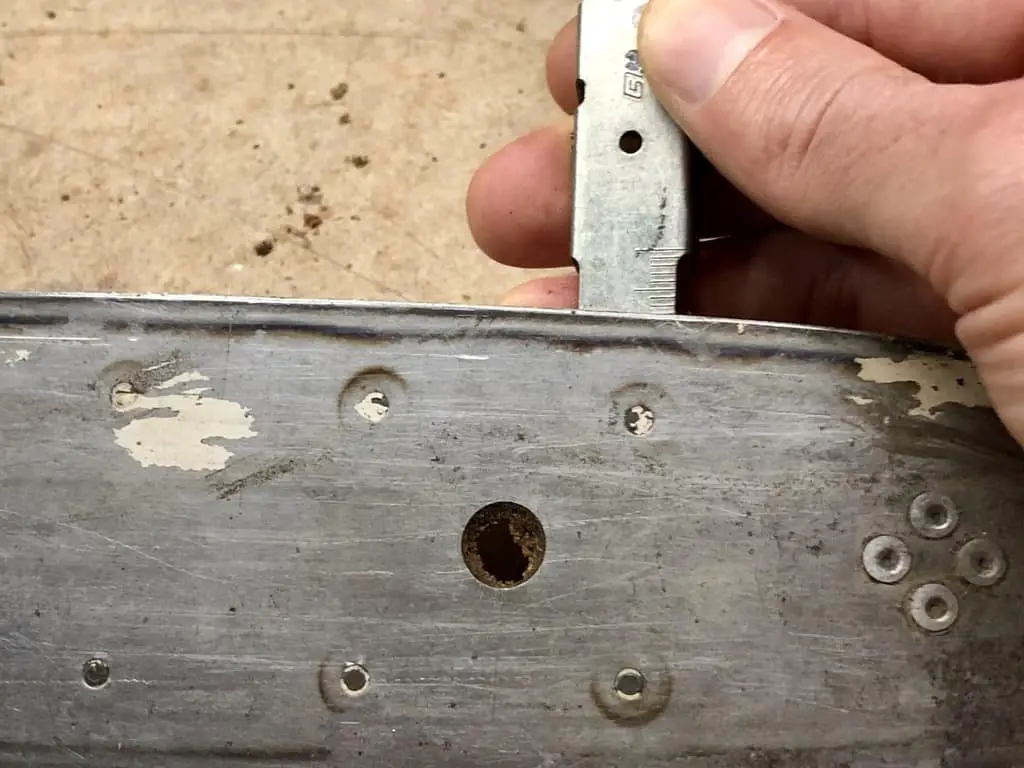
On each gauge tool there is a mark that designates when a bar is too low to be used. Check out the picture below to see the mark I’m talking about.

If the bar is lower than this mark then it’s time to get a new bar.
How to Tell When a Chainsaw Bar Track is Too Wide
Just as friction can wear down the height of the bar track, it can also wear down the width of the bar track.
If your bar track gets too wide it can cause your chain to jump out of the track which is not a good thing.
Here’s two ways to tell if your bar track is too wide.
First, put on a pair of gloves, safety first, and make sure your chain is properly tensioned. Then, pinch the chain between your fingers and try to wiggle it side to side.
If the chain wiggles quite a bit then your bar track is probably worn out and needs to be replaced.
For the other way to tell if your track is worn out you will need a ruler or a pencil or some kind of flat object.
Make sure your chain is properly tensioned, take your flat object of choice, and hold it up against the side of the bar so it is touching the outside cutter on the top and touching the chain on the bottom. Like this:
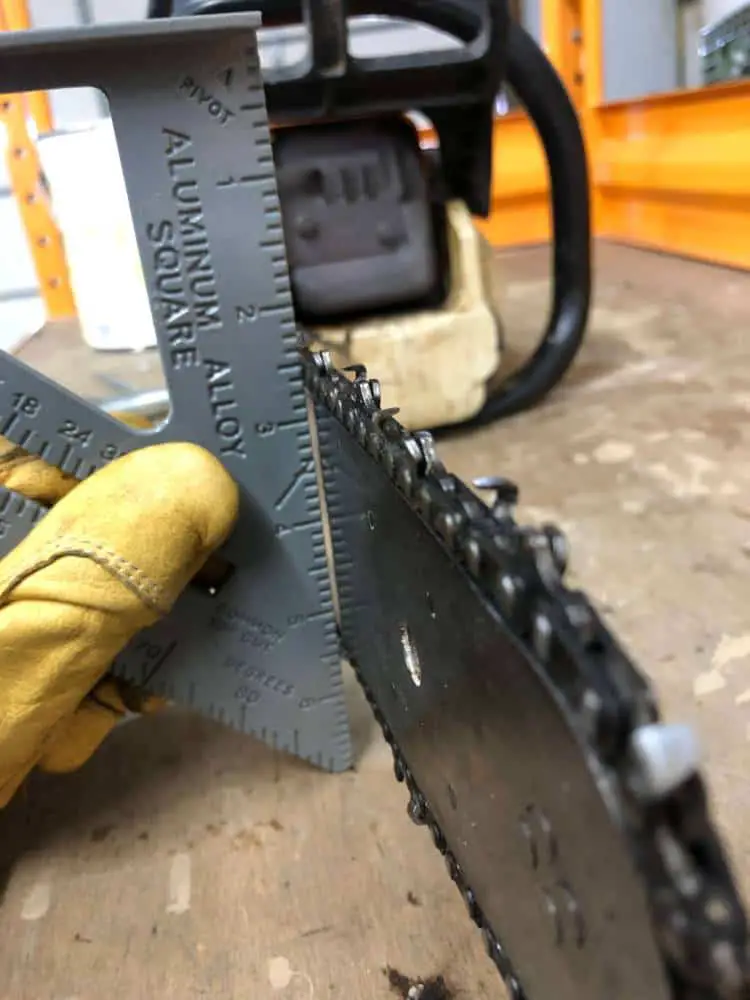
Press the flat object in towards the bar and the look on the side. There should be a gap between the object and the bar.
If the object is flush with the bar, then the chain has quite a bit of play in it from side to side. This means that your track is getting to the point where it needs to be replaced.
How to Tell When There are Pinches in the Bar Track
Pinches in your bar are exactly what they sound like. They occur when the sides of your bar track have been pinched or pushed inward.
These pinches cause extra friction on your chain which is bad for your chain, bar, and your chainsaw motor.
If you find some pinches on your bar and you aren’t sure how long they’ve been there, you may want to check your chain for wear and tear.
To spot these pinches, remove the bar and chain and separate the chain from the bar. Look down the bar track on both sides. Look for any areas that are pressed inwards.
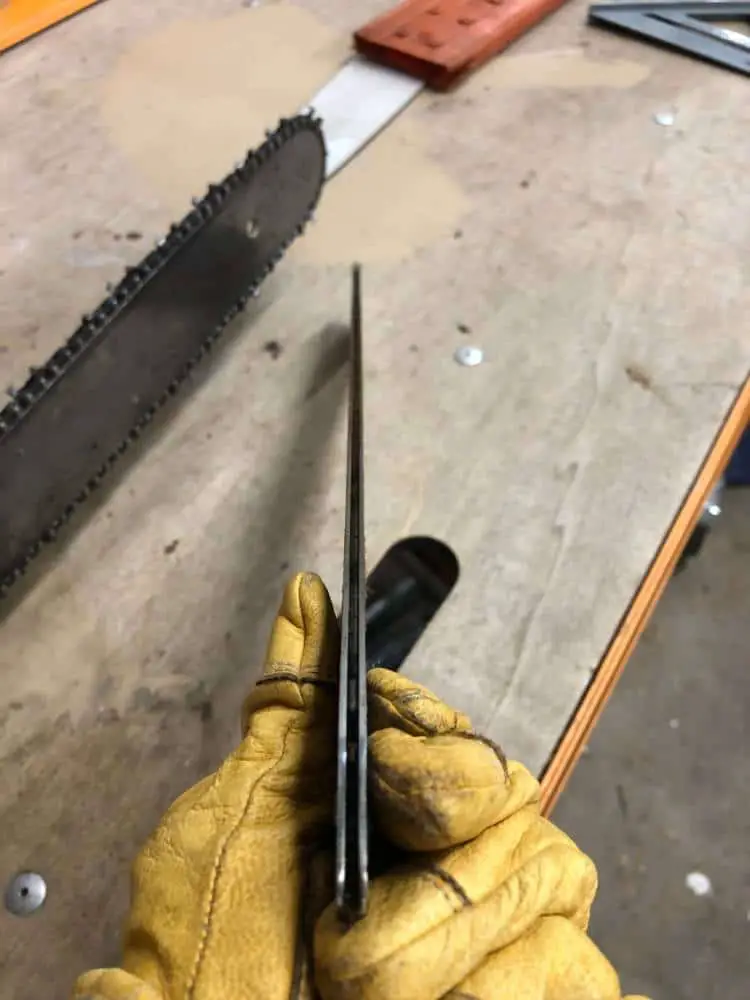
This bar looks nice and straight, no pinches to be seen.
Unfortunately, if you have pinches in your bar, they cannot be fixed. If you have any pinches, you will need to buy a replacement bar.
How to Tell When a Nose Sprocket is Damaged
Now, if you’re new to the world of chainsaw, you may not even know what a nose sprocket is.
The nose sprocket is on the end of the chainsaw bar, it has teeth and spins just like the sprocket on the other end of the chainsaw.
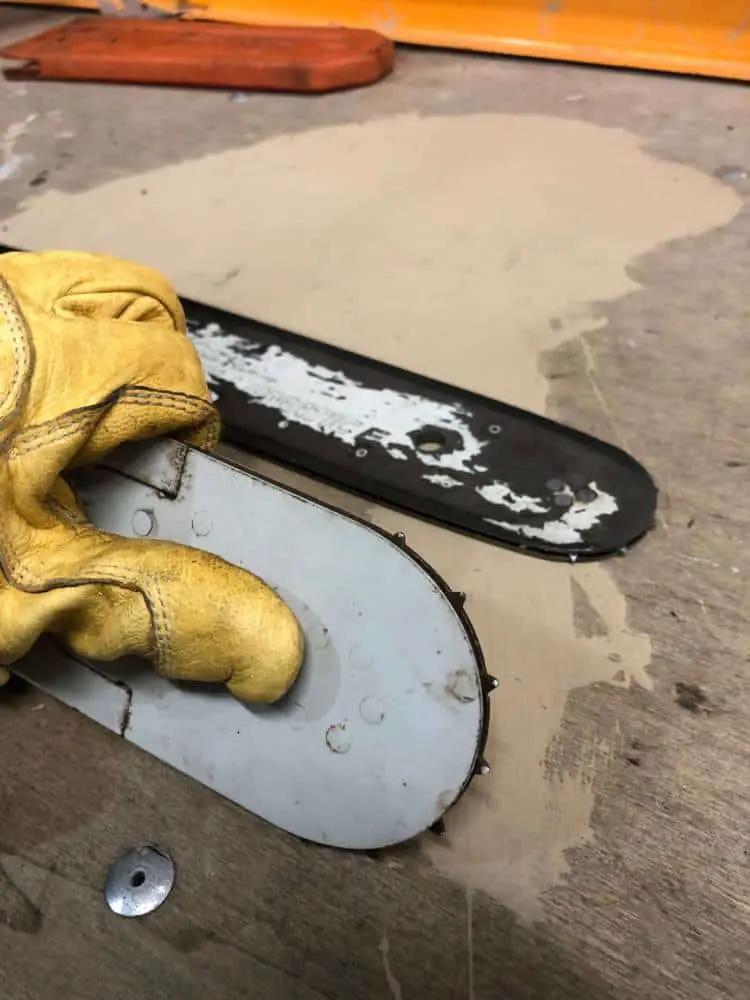
The nose sprocket helps the chain to move across the nose of the bar as well as helps keep the chain in place.
The sprocket can become damaged if the teeth become bent or even missing.
To inspect the nose sprocket, remove the chain from the bar and look at the teeth of the nose sprocket. Manually spin the sprocket to check all the teeth.
Also, clean the nose sprocket as much as you can. Just like the bar track, the nose sprocket can get gunked up from the mix of sawdust and bar and chain oil.
Some chainsaw bars have removable nose pieces. If this is the case, you can replace a broken or damaged nose sprocket.
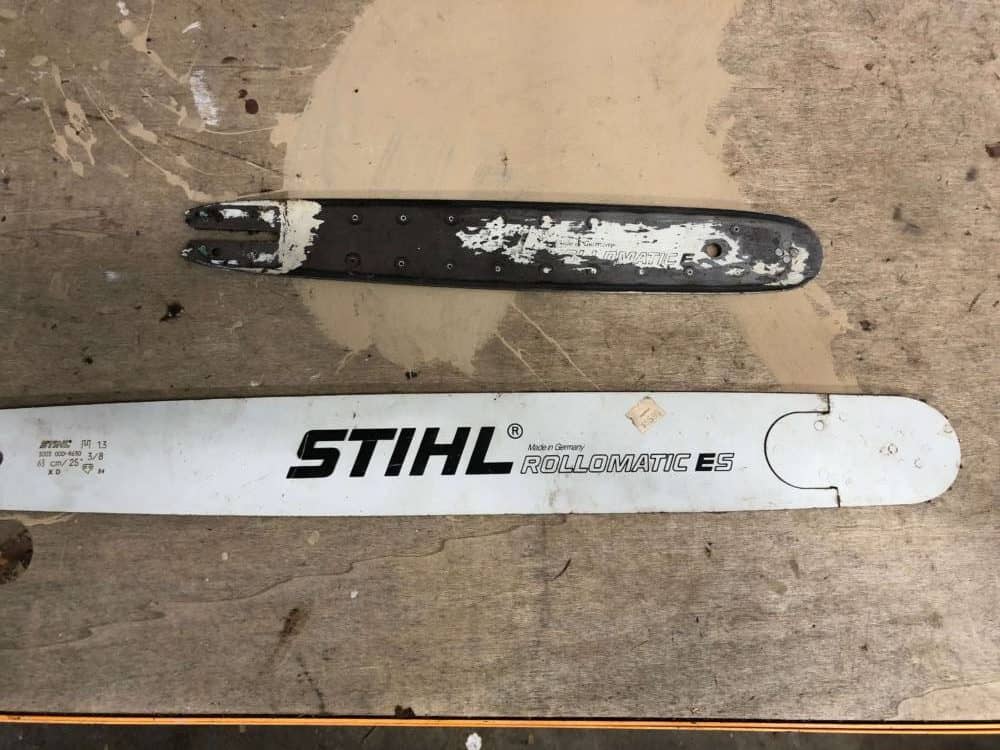
In this picture, the long white bar has a removable nose piece.
However, if you go to replace the nose sprocket and the sides of the nose piece don’t match the sides of the rest of the bar track, then this is a sign you should replace the whole bar, not just the nose sprocket.
When to Replace a Chainsaw Bar
Chainsaw bars can last an extremely long time. If you take good care of them, they could even last as long as the chainsaw itself.
Logically, the more often you use your chainsaw, the faster the bar will wear out. There is no time limit to how long a bar lasts, rather the life of a chainsaw bar is based on wear and tear.
If your bar track is too low, too wide, there are pinches in the track, or there is damage to the nose sprocket, these are all things that indicate your bar needs to be replaced.
If you are not sure which bar is compatible for with your chainsaw, check out our step by step guide on how to buy the right chainsaw bar.
If your bar is bent but not too badly, that can be fixed and may not require a replacement.
Running your chainsaw without bar and chain oil can burn and damage the bar.
If your bar starts to have a black streak along the bar track, see below, this is a sign that your bar has been run without bar and chain oil.

The increased friction from the lack of oil can cause some severe wear to your bar. If our bar starts to look like this, give it a serious inspection to make sure it’s still usable.
When you’re running your saw for a long project, check your bar and chain oil every time to stop to refuel.
To ensure that your bar lasts as long as possible, clean it and check it regularly for damage. I would say check it every time your change your chain or take the front panel off.
Another tid bit about bar wear, the bar will wear out the most where it cuts the most. This is usually along the bottom of the bar where you press it against the wood.
To help your bar wear evenly, every time you take it off to clean and inspect it, put it back on upside down from the way it was before.
This will help it wear evenly and last even longer.
Wrap Up
The chainsaw bar is a vital part of your chainsaws operation. If it becomes worn out, it can make your chainsaw less efficient and even dangerous.
Make sure you check the bar for bends, the bar track sides for width and height, pinches in the bar track, and damage to the nose sprocket.
I would give your bar a good once over every time you change your chain.
If you take good care of your equipment, it could last you a lifetime. Now go do something awesome!
Related Questions
Can you change the bar length on a chainsaw?
Chainsaws have a range of bar lengths that they can use. The reason for this range is based on the size of the engine your chainsaw has. The larger the engine, the longer the bar your chainsaw can have. We have a whole article dedicated to this topic here. It also has an awesome chart that will tell you the range of bar for common chainsaw motors.
How long does a chainsaw bar last?
Unless a chainsaw bar becomes bent or damaged, a chainsaw bar could outlast the chainsaw itself. If you only use a chainsaw a few times a week, it will last several years. A chainsaw could be run continuously for a year and still be perfectly fine. But, if it gets damaged it will need to be replaced.
